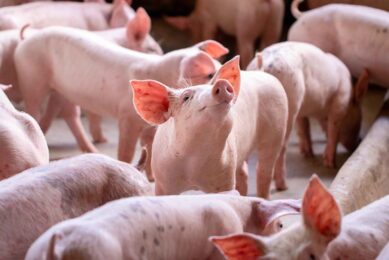Research: A cure for PRRS

A research team from the University of Missouri and Kansas State University has been working to find a cure for Porcine Reproductive and Respiratory Syndrome Virus (PRRS).
PRRS can inhibit pigs from reproducing and slow the growth of young pigs.
“Initially, scientists believed that PRRSV bound to a specific molecule, known as CD169, and infected white blood cells in the lungs,” said Randall Prather, distinguished professor of reproductive biotechnology in the MU College of Agriculture, Food and Natural Resources. “In our study, we’ve found that this is probably not how the virus is infecting pigs.”
In the study, Prather genetically modified a litter of pigs so they would not generate the CD 169 molecule; therefore, the virus would have nothing to bind to and would be killed by the pigs’ natural immune systems. However, after an initial test, the genetically modified pigs did become infected with PRRS virus, negating the initial theory.
“While we didn’t find what we were looking for, we did uncover important information about the infection,” Prather said. “This information will help us narrow our search as we continue to fight this virus. We’ll keep searching for answers until we determine how to stop PRRS virus.”
When pigs are infected with the disease, farmers must clean everything, Prather said. That means culling the herd, cleaning the barns and letting the pens sit empty until all viral material is killed. If that doesn’t happen, the virus can continue infecting new groups of hogs. Farmers have had access to vaccines for the last two decades, but experts warn they are not the best tool to fight the disease.
“Vaccines have been shown to lessen the impact of the disease on farms, but they are not a good tool to control or eradicate the virus,” said Raymond (Bob) Rowland, co-author of the study and professor of virology at the Kansas State University College of Veterinary Medicine. “With this new information, we understand more about the mechanisms of this virus and how it acts once inside the pig’s body.”
Both Prather and Rowland agree that the study was only possible due to the collaboration of the scientists in their respective laboratories.
“To go and find these answers to the problems plaguing farmers, I need to find friends that have expertise in areas that I don’t know anything about,” Rowland said. “Randy Prather knows genes; I know viruses. Together, we can get a lot of work done very quickly.”
The study, “An intact sialoadhesin (Sn/SIGLECI/CD169) is not required for attachment/internalization of the porcine reproductive respiratory syndrome virus (PRRS),” was recently published in the Journal of Virology.
Source: University of Missouri











